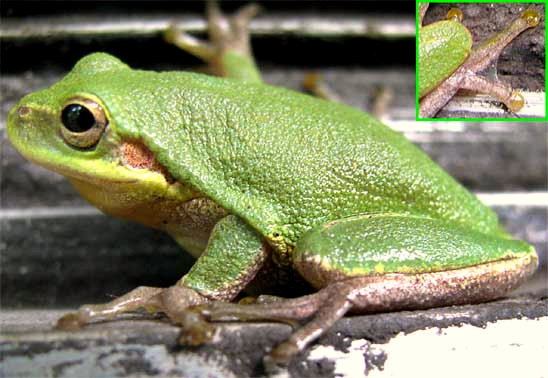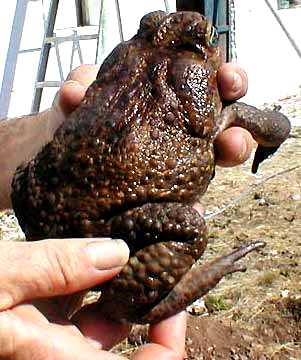
FROG FEATURES
The above picture shows a Squirrel Treefrog, Hyla squirella, a species living on the Coastal Plain in the US Deep South. This picture shows a typical frog feature, that of protruding eyes. This enables the frog to poke its eyes above the water's surface for an above-water view, while nearly all the rest of the body remains safely underwater.
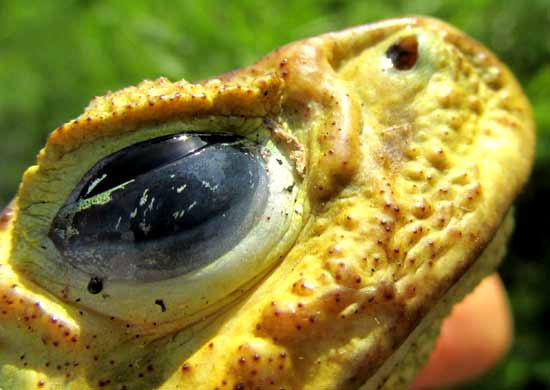
Frog eyes have eyelids, both upper and lower ones, and both are transparent. There's also what some call a "third eyelid," known technically as a nictitating membrane. It's tougher and fairly opaque, and rises from below the eye. At the right you see how a Giant Toad raised his nictitating membrane when bright sunlight began bothering him.
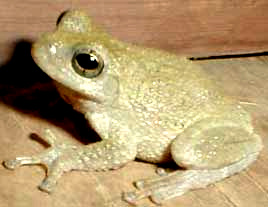
On the Squirrel Treefrog at the left, notice the circular, item behind and a little below the eye. That's a round eardrum, or tympanic membrane. When soundwaves strike this membrane, the frog hears. The membrane is larger in male frogs than in female frogs.
Also notice that the Squirrel Treefrog's feet have roundish toe pads, which is typical of treefrogs. Toe pads are sticky adhesive pads used in climbing.
FROGS MAKE SOUNDS
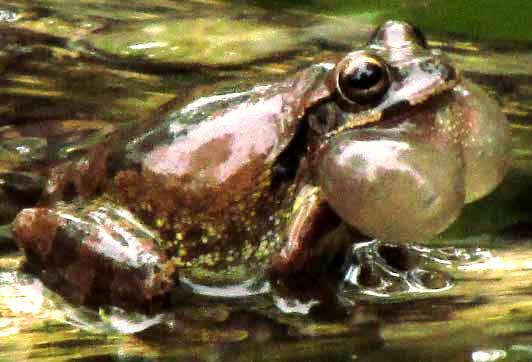
It's wonderful to hear male frogs calling for females. It's been shown that often females can judge how robust a male is by how well and how loudly he calls. In the picture of the Mexican Treefrog at the right you can see how, while calling, two pouches, or vocal sacs, below the frog's mouth are blown up, or distended, like balloons. Some frog species have only one pouch, others two.

When a frog calls, like the Gulf Coast Toad, Bufo valliceps, at the left, it forces air from its lungs across its vocal cords, which vibrate, causing the sound. Vocal sacs serves as resonators, like the bodies of guitars, increasing the call's volume tremendously. Air passing across frog vocal cords doesn't escape the frog; It's recycled back and forth between the lungs and mouth cavity, so frogs can call continually without having to pause for a breath.You may be able to hear a variety of frog calls on AnimalDiversity.Org's Frog Calls page.
LISTING & LISTENING TO YOUR LOCAL FROGS
For learning your local frogs and toads, a good start is to go through your amphibian field-guide and, looking at the distribution maps, list each species that can possibly occur in your area. Next to the name write what that species' voice sounds like. Below is such a list made for near Natchez, Mississippi. The voice descriptions are adapted from information in The National Audubon Society Field Guide to North American Reptile and Amphibians, by John Behler:
- Bullfrog.................deep-pitched JUG O'RUM
- Bronze Frog..............single twang of loose banjo string
- Pickerel Frog............steady low croak
- Southern Leopard Frog....series of short, throaty croaks
- Northern Cricket Frog....shrill, measured clicking
- Southern Cricket Frog....cricket-like clicks of 1 or 2 notes
- Green Treefrog...........quank, quank, quank...
- ? Bird-voiced Treefrog...resonant, bird-like whistles
- Cope's Gray Treefrog.....hearty, resonating trill
- Common Gray Treefrog.....as above, but slower
- Spring Peeper............high-pitched ascending whistle
- ? Pine Woods Treefrog....like tapping together of wooden dowels
- ? Barking Treefrog.......single bell-like or loud barking
- Chorus Frog..............like fingernail run along comb teeth
- Squirrel Treefrog........nasal trill, quack or grating call
- American Toad............musical trill up to 30 seconds long
- Woodhouse's Toad.........bleat of sheep with a cold
- ? Oak Toad...............single high-pitched whistle like bird
- E. Narrow-mouthed Frog...weak bleat of a sheep
- ? Eastern Spadefoot......coarse, low-pitched call of young crow
The question marks denote species whose distribution map places Natchez, Misssissippi on the boundary of distribution, so they may or may not exist there.

MORE FUN WITH FROGS
If there's a froggy place in your neighborhood, you're very lucky, and it can be great fun to figure out what kind of frogs you have. You can watch them with flashlights when they're croaking and mating, especially on rainy nights in the spring, and even on the warmer nights of winter.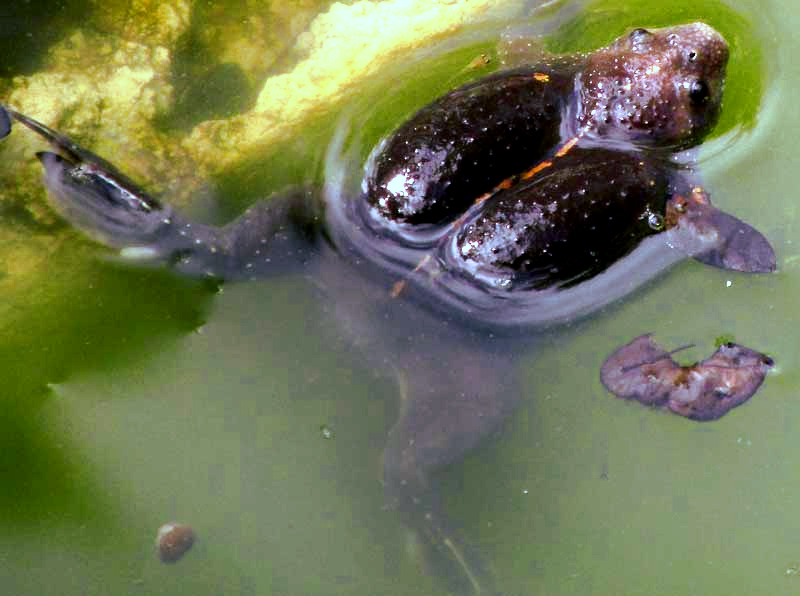 As in the case with birds, you can learn to identify frogs and toads by their voices. Maybe someday you'll spot or at least hear something as unusual at what's shown at the right. That's a Sheep Frog, Hypopachus vriolusus, his back weirdly bloated, a behavior not well documented in scientific literature. This species occurs from southern Texas south to Nicaragua.
As in the case with birds, you can learn to identify frogs and toads by their voices. Maybe someday you'll spot or at least hear something as unusual at what's shown at the right. That's a Sheep Frog, Hypopachus vriolusus, his back weirdly bloated, a behavior not well documented in scientific literature. This species occurs from southern Texas south to Nicaragua.
One way to have some fun while conducting your frog-studies is to become a "Frogwatcher" in association with the US Geological Survey Patuxent Wildlife Research Center. Here you can help monitor frog numbers and submit data on them in official format. You can sign up and get all the info you need at the Frogwatch USA site. In Canada you can submit your frog findings to Nature Canada's FrogWatch.

